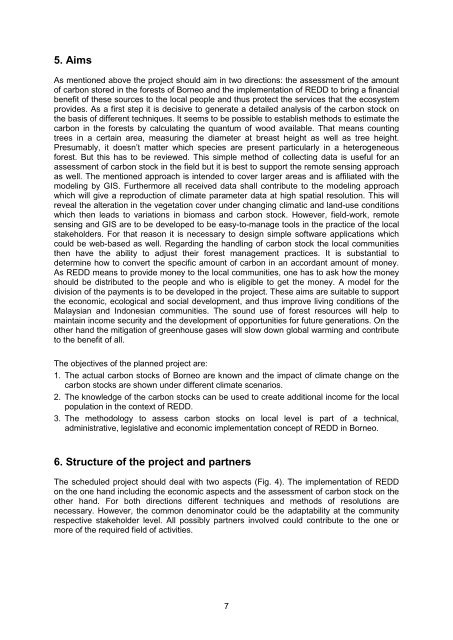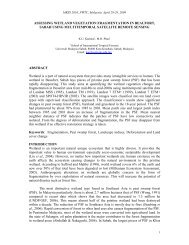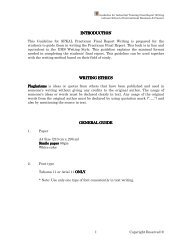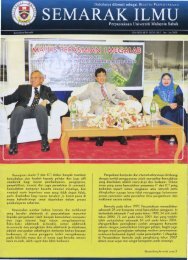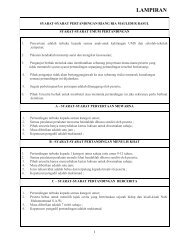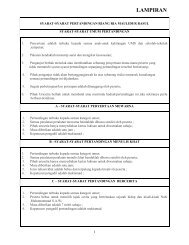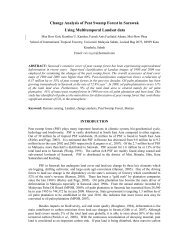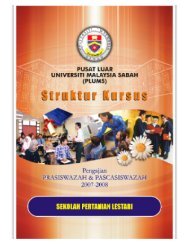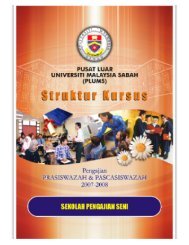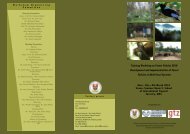Report for the German Agency for Technical Cooperation (GTZ) - UMS
Report for the German Agency for Technical Cooperation (GTZ) - UMS
Report for the German Agency for Technical Cooperation (GTZ) - UMS
Create successful ePaper yourself
Turn your PDF publications into a flip-book with our unique Google optimized e-Paper software.
5. Aims<br />
As mentioned above <strong>the</strong> project should aim in two directions: <strong>the</strong> assessment of <strong>the</strong> amount<br />
of carbon stored in <strong>the</strong> <strong>for</strong>ests of Borneo and <strong>the</strong> implementation of REDD to bring a financial<br />
benefit of <strong>the</strong>se sources to <strong>the</strong> local people and thus protect <strong>the</strong> services that <strong>the</strong> ecosystem<br />
provides. As a first step it is decisive to generate a detailed analysis of <strong>the</strong> carbon stock on<br />
<strong>the</strong> basis of different techniques. It seems to be possible to establish methods to estimate <strong>the</strong><br />
carbon in <strong>the</strong> <strong>for</strong>ests by calculating <strong>the</strong> quantum of wood available. That means counting<br />
trees in a certain area, measuring <strong>the</strong> diameter at breast height as well as tree height.<br />
Presumably, it doesn’t matter which species are present particularly in a heterogeneous<br />
<strong>for</strong>est. But this has to be reviewed. This simple method of collecting data is useful <strong>for</strong> an<br />
assessment of carbon stock in <strong>the</strong> field but it is best to support <strong>the</strong> remote sensing approach<br />
as well. The mentioned approach is intended to cover larger areas and is affiliated with <strong>the</strong><br />
modeling by GIS. Fur<strong>the</strong>rmore all received data shall contribute to <strong>the</strong> modeling approach<br />
which will give a reproduction of climate parameter data at high spatial resolution. This will<br />
reveal <strong>the</strong> alteration in <strong>the</strong> vegetation cover under changing climatic and land-use conditions<br />
which <strong>the</strong>n leads to variations in biomass and carbon stock. However, field-work, remote<br />
sensing and GIS are to be developed to be easy-to-manage tools in <strong>the</strong> practice of <strong>the</strong> local<br />
stakeholders. For that reason it is necessary to design simple software applications which<br />
could be web-based as well. Regarding <strong>the</strong> handling of carbon stock <strong>the</strong> local communities<br />
<strong>the</strong>n have <strong>the</strong> ability to adjust <strong>the</strong>ir <strong>for</strong>est management practices. It is substantial to<br />
determine how to convert <strong>the</strong> specific amount of carbon in an accordant amount of money.<br />
As REDD means to provide money to <strong>the</strong> local communities, one has to ask how <strong>the</strong> money<br />
should be distributed to <strong>the</strong> people and who is eligible to get <strong>the</strong> money. A model <strong>for</strong> <strong>the</strong><br />
division of <strong>the</strong> payments is to be developed in <strong>the</strong> project. These aims are suitable to support<br />
<strong>the</strong> economic, ecological and social development, and thus improve living conditions of <strong>the</strong><br />
Malaysian and Indonesian communities. The sound use of <strong>for</strong>est resources will help to<br />
maintain income security and <strong>the</strong> development of opportunities <strong>for</strong> future generations. On <strong>the</strong><br />
o<strong>the</strong>r hand <strong>the</strong> mitigation of greenhouse gases will slow down global warming and contribute<br />
to <strong>the</strong> benefit of all.<br />
The objectives of <strong>the</strong> planned project are:<br />
1. The actual carbon stocks of Borneo are known and <strong>the</strong> impact of climate change on <strong>the</strong><br />
carbon stocks are shown under different climate scenarios.<br />
2. The knowledge of <strong>the</strong> carbon stocks can be used to create additional income <strong>for</strong> <strong>the</strong> local<br />
population in <strong>the</strong> context of REDD.<br />
3. The methodology to assess carbon stocks on local level is part of a technical,<br />
administrative, legislative and economic implementation concept of REDD in Borneo.<br />
6. Structure of <strong>the</strong> project and partners<br />
The scheduled project should deal with two aspects (Fig. 4). The implementation of REDD<br />
on <strong>the</strong> one hand including <strong>the</strong> economic aspects and <strong>the</strong> assessment of carbon stock on <strong>the</strong><br />
o<strong>the</strong>r hand. For both directions different techniques and methods of resolutions are<br />
necessary. However, <strong>the</strong> common denominator could be <strong>the</strong> adaptability at <strong>the</strong> community<br />
respective stakeholder level. All possibly partners involved could contribute to <strong>the</strong> one or<br />
more of <strong>the</strong> required field of activities.<br />
7


